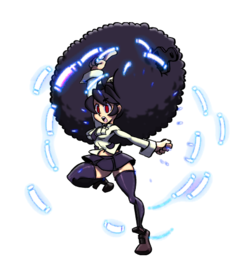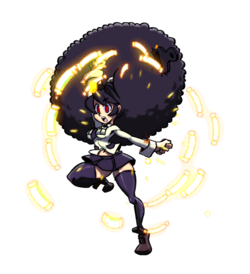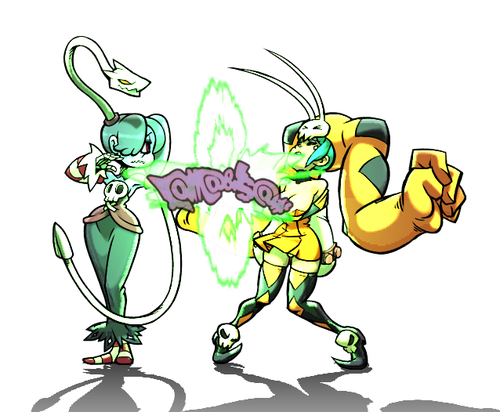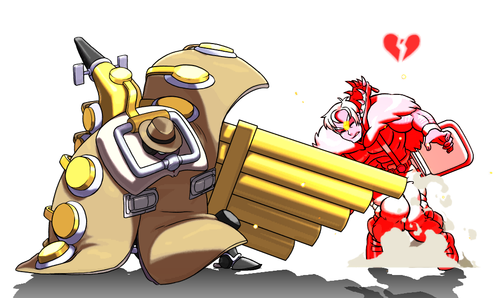Skullgirls/Combo Mechanics
Combos
A combo is any series of attacks that are unblockable for the opponent after the first hit. The attacking player can create any number of elaborate combos with the creative use of a few, fundamental mechanics.
Cancels
- Normals and command normals cancel into any special move or super during all start up, active, and recovery frames. Normals that whiff can still cancel to a special move or super.
- Air normals and command normals all cancel to an air dash for characters that have an air dash. Air dash canceling works during start up, on whiff, block, or hit similar to canceling to a special move.
- Specials always cancel into supers on start up. They cancel during active frames and part of recovery frames on hit or block. Late recovery frames can never cancel. No active or recovery frames can cancel for a missed special move.
Chains
All characters can chain cancel their normal moves into other normals on hit or block. Any move from an attack button lower on the chain will cancel to an attack higher on the chain during all active and some of the recovery frames. Standing, crouching, and command normals can appear in the same ground chain. Air normals and air command normals work in the same air chain. Different characters have different chain combo sequences for their ground and air chains, and maximum number of attack buttons in the chain describes the different chain types.
- 6 button chain:
 →
→  →
→  →
→  →
→  →
→ 
- 5 button chain:
 →
→  →
→  →
→  →
→  or
or 
- 4 button chain:
 →
→  →
→  or
or  →
→  or
or 
- 3 button chain:
 or
or  →
→  or
or  →
→  or
or 
Normal moves with the Chains Twice or Chains Thrice properties and Cerebella's j.LP can all chain into themselves. Self-chaining moves can still cancel into higher buttons in the chain. Chain cancels do not usually work on whiff, but self-chaining attacks will.
Links
A link allows a move to hit then completely animate and end without canceling, leaving the opponent in enough hit or block stun for another move to connect. Using links to combo normal moves often requires strict, frame specific timing and is more difficult than creating a combo using only cancels. The most important links appear in air combos that use unchained normals, which can be useful for getting a lander off of an otherwise simple launcher into air combo.
OTG Hits
The attacking player can hit the opponent off the ground once per combo. Anything can OTG if it hits low to the ground, even if it isn't a low move. During a typical knockdown any hit that lands on the opponent after a red impact effect but before the blue impact effect (and available ground recovery) consumes the one OTG. Hitting the opponent while the are on the ground from a sliding knockdown or late into the crumple stun also uses the one OTG for that combo.
Assists in Combos
- An assist can only be called once during a combo.
- Starting a combo off of an assist's attack gives the combo 66% damage scaling. If an assist counter hits and starts a combo, it causes only 90% damage scaling.
More mechanics that affect assists in combos
- Outside of assists being only usable once per combo, there are mechanics in place that can still consume your assist usage in a combo.
- Anything from a character hitting while it is not the point character will use up the assist usage that combo if one has not been used yet.
- Examples: DHCs that leave projectiles on the screen (argus to SSJ, Sniper Shot unscaling, Puddle to other DHC) will use up the assist call for that combo.
- Similarly, setups for tag combos that have something from the tagging-out character hit while the tagged in character is on the screen will use up the assist call. Examples include double's Puddle, Peacock bombs, Fortune headless setups, and others. Related, if the tag transition happens while the opponent is in hitstop of a projectile that was from the old point character, it will use up that combo's assist call even though it "technically" it still hit while the old point was on screen. This mostly affects Fukua but can also affect peacock, fortune, beo, and parasoul.
Restands
If the opponent hits the ground in hit stun from a non-knockdown move they land on their feet and get 1 extra frame of hit stun. Restands are independent from OTGs and nothing restricts multiple restands in the same combo. Both ground and air moves can cause an opponent to land during a combo.
Recovery Spark
If a defending character takes a 3 or more hit combo then recovers directly to a normal state without a knockdown, the defending character will show a recovery spark effect. This has no affect the defending character, but can signal the defending player after the abrupt end of an opponent's combo.
Character Specifics
Weight
The game's engine considers character weight whenever the defending character gets hit, starts falling, or changes momentum for any reason. Launchers will generally send a lighter character further than the a heavier character. Certain air combos will not work against every character because of this subtle detail.
| Lights | Filia/Fukua, Peacock, Ms. Fortune, Painwheel, Valentine, Squigly |
|---|---|
| Mediums | Cerebella, Parasoul, Eliza *, Beowulf, Robo-Fortune |
| Heavies | Double, Big Band |
* Eliza behaves as a lightweight when she is not in hitstun
Hurtboxes
Every character has unique hurtboxes, some with differences that may cause a need for combo adjustments. This is a non-comprehensive list of some character's unique hurtbox traits.
- Big Band's hurtboxes are taller and wider than the rest of the cast by far. While he is the only other heavy character alongside Double, this trait makes him even more unique to combo on.
- In addition to being the only two heavy characters, Double and Big Band are significantly taller than the rest of the cast. Eliza is slightly taller than average.
- Squigly's hurtboxes are thinner than average.
- Peacock and Beowulf's hurtboxes are a bit wider than average.
- Cerebella's hurtboxes sometimes make combos drop due to the unique shape.
Bursts
Combo length in Skullgirls is limited by two systems: the infinite protection system (IPS) and undizzy. Both act as a set of rules for what you can do in a combo, and if the rules are broken, they both result in the opponent being able to burst. When the opportunity to burst is available, the hitsparks and hit sounds will change. Once that happens, the burst can be performed by pressing any button. Bursts can be done until the character returns to a neutral state. If OTG is spent, then ground teching after a knockdown without bursting is allowed.
The first burst condition, IPS, will be triggered if a combo starts a new chain with a button that has already been used in the combo. The buttons used in the jump in and first ground chain will not be tracked. But after that, each button is tracked by IPS and if a new chain is started with a tracked button, IPS will trigger and the opponent can burst.
The other burst condition, undizzy, is a numerical value that increases as the opponent is getting hit and is represented by the green bar underneath the health bars. If a combo starts a new chain after the undizzy bar is filled, the opponent can burst. This is not just a combo length limiter, since combos at full undizzy come with a penalty, and the undizzy value does not immediately return to 0 after the combo ends. This effectively keeps resets in check, as doing a high damage combo into a reset will be less rewarding. Eventually, the attacker has to "let the opponent play", otherwise, the amount of mixups needed to kill a character are much higher than normal
All characters have identical properties for their burst: 10f of invincible start up, 23f active frames, and 28f of recovery. On hit, the burst deals no damage but will scale damage to 50% if it starts a combo. Under normal circumstances, both characters will recover on the same frame after a blocked burst.
Bursts are not a fail safe option, and can be baited to whiff and be punished. Whether or not the burst's recovery is vulnerable or not is determined by the type of burst. There are gold bursts (safe) and blue bursts (unsafe / punishable). The color is indicated by the effect surrounding the character when they perform a burst. There are a few factors that determine the color.
- If a burst hits or is blocked, it is always gold (safe).
- If the player bursts a projectile hit, it is always gold (safe).
- If the player waits 90f after a burst becomes available to burst, it will be gold (safe).
- Otherwise, if the burst whiffs completely, it is blue (unsafe / punishable)
For blue bursts, the recovery frames are vulnerable and there is an additional period of recovery as the character falls slowly to the ground and lands standing.
The Infinite Prevention System (IPS)
The rules are still simple to explain - "don't start a chain with something you already hit with, and your combo is always legit." You get 2 free sections before moves are even counted toward this limit (your first and second chains) and one more free section where moves are kept track of but the limit isn't enforced yet (the entirety of your jump if you're in the air, or your next chain if you aren't). That's it. You can determine exactly whether or not a combo is possible just by writing it out: "Did I already use s.LP? OK, can't start another chain with that." And if something doesn't work, the hitsparks change color and you immediately know which move caused it. You also immediately know why, because the ONLY THING that would cause it is you having used that move before. [1]
"Don't start a chain with something you've already hit with" is the only rule. The exception is your first jumpin sequence, first ground chain and first air combo. [2]
- Mike_Z
Bursts from IPS will results in red hitsparks. This does not affect the resulting burst, it's just to indicate how the burst happened.
Combo Sections and Stages
IPS reads combos in smaller sections, chains, or loops as they happen. It offers the most freedom to the attacking team during the first sections. As the combo continues, the combo stage increases. A higher combo stage represents increasing restrictions on a combo as it becomes closer to an infinite. Any attack can start a new section, which will continue through any chain combo of normals, a cancel into a special move, or a cancel into a super. Leaving the ground with a jump, landing on the ground, air dash canceling, and preforming a link in a combo all start a new section for the combo and increase the combo stage.
The training room's combo stage counter shows the player exactly when IPS increases the restrictions for the combo by counting up from 0 to 5. The IPS effectively ignores the combo for the first free sections, remembering all attacks used in a combo starting with the first watched section. After a combo reaches the maximum combo stage, the IPS continues to watch and remember every attack and can trigger for a burst. Starting any additional section with a move that was previously used in a watched section will trigger IPS.
- Order of combo stages:
- 1: Free: Optional section for a chain of jump-in attacks; cancelling to an air dash will end the chain and start Stage 2.
- 2: Free: The next chain, usually the first ground section.
- 3: Watched: The next chain.
- 4: Watched: Optional section, allowing one additional chain before Stage 5 if using an air dash cancel.
- 5: Limited: Maximum stage, same as watched and can trigger a burst.
Additional Rules
- All standing, crouching, and command normals from the same button count as the same attack to IPS. Once one version of the normal gets watched, all versions are watched. IPS considers air normals separate attacks but are similarly tied to any air command normals on the same button.
- Different button strengths of same special move count as the same attack to IPS; once one strength of the special attack gets watched, all of them are watched. Similar to normal attacks, IPS watches the air version of specials separately and considers all strengths as one move.
- Supers are never watched and can't trigger IPS. Bursts can be preformed while getting hit by a super if something else triggered IPS first.
- Assists count as their own section. IPS will watch assists and remember them if the assist character becomes the point character before the end of the same combo.
- A throw, if used in a combo after a stagger or crumple stun, counts as its own section. Starting a combo with a throw will start the combo at Stage 2. Throws and hit grab attacks cannot trigger IPS. Bursts can never be preformed during a throw's scripted animation.
- Watched attacks will carry over to a teammate if the teammate takes point after a standard tag, but not after a DHC.
- Starting a combo with a super that allows a combo afterwards will treat the next chain as either Stage 2 or Stage 3, depending on the super.
- Continuing a combo with a DHC will instantly begin Stage 5. If the DHC starts a new combo, it's treated like a normal super.
Character-Specific Rules
- Cerebella's j.LP will infinitely chain into itself but can only trigger IPS on its first hit.
- Parasoul's j.MK and (air) ↓ + MK can chain into any of her other air normals. Chaining "down" will start a new combo section.
- The direct hit from Parasoul's Napalm Shot will get watched like any other special move. IPS ignores the exploding tears from this attack.
- The explosion from Parasoul's Napalm Toss will get watched like any other special move. Although placing the tear does not cause a direct hit, chaining into the special move means the tear will not trigger IPS when it eventually does explode.
- If Parasoul cancels the recovery of an (air) Napalm Toss to start a second air chain in the same jump, it is considered the same as an air dash cancel to IPS and can be used to get a Stage 4 chain.
- IPS completely ignores Ms. Fortune's head. Hit from the head can never trigger IPS, the head's attacks are never watched, and it can't start a new section or increase the combo stage for the body.
- Painwheel's Flight is considered the same as an air dash cancel to IPS and can be used to get a Stage 4 chain.
Undizzy
The undizzy gauge complements the IPS system and can trigger a burst based on a parallel set of rules. The undizzy bar incentivizes doing shorter combos into resets, and makes doing max damage combos into a reset less rewarding. Working within the limits of your accumulated undizzy to execute unpredictable resets on the fly is key at a high level.
Once a combo reaches stage 3, additional hits in a combo begin to fill the opponent's undizzy gauge (the green bar below their health). If the combo reaches Stage 5 and the defending character has 240 or more undizzy, the start of any new chain in the combo will show a green version of the IPS hit effect and allow the opponent to execute a burst.
Small detail about stage 3 and assists: if the point recovers from their last move, and then an assists hits after that, the assist hits in stage 3 and the assist adds undizzy.
Bursts from undizzy will result in green hitsparks. This does not affect the resulting burst, it's just to indicate how the burst happened.
Undizzy is also known as drama.
Accumulating Undizzy
Attacks add undizzy based on set values for the type of move:
- Light normals: 15 undizzy
- Medium normals: 20 undizzy
- Heavy normals: 30 undizzy
- Any special: 20 undizzy
Other attacks, such as normal throws or supers, do not build undizzy. Assists add appropriate undizzy for the assist's attack type. An attack that chains into itself and attacks with multiple hits will add undizzy only on the first successful hit.
Characters can accumulate an undizzy value beyond 240, although it will not be reflected on the HUD.
Depleting Undizzy
Undizzy decays over time when the opponent is not in hit or block stun, and if it accumulates over the 240 limit it will take even longer to clear. A full undizzy gauge will drain over a maximum of 60f for 350+ undizzy, scaling from a slightly slower decay rate at values over 150 to a faster rate as the bar empties.
When undizzy is at or above 240, the bar will wait for 4f after recovery from hitstun before starting to decrease. This means resets must leave a larger window in order to deplete undizzy.
A ground tech immediately clears 50% of current undizzy.
Bursting will remove all undizzy.
Counter hits subtract undizzy, which can put undizzy on the defending character to a negative value and allow for some impressive counter hit only combos. Undizzy subtracts on counter hit according to the type of attack:
- Light normals: -25 undizzy
- Medium normals: -50 undizzy
- Heavy normals: -100 undizzy
- Normal throws: -50 undizzy
- Specials: -50 undizzy
- Any assist: -25 undizzy
- Supers: 0 undizzy
Side Effects
- All damage when above 240 undizzy is scaled by 55%, with the same minimums as normal.
- When at or above 240 undizzy, the attacker always gets the minimum scaled meter gain and the opponent always gets the maximum.
- Once a combo becomes burstable via undizzy (green hitsparks), damage is scaled by an extra 50%, and can go below minimum damage scaling. This doesn't apply to bursts via IPS (red hitsparks).
- If a character performs a level 1 or 2 super while that character possesses any amount of undizzy, the super becomes blockable after the flash if the other character hasn't already committed to an action.
Health and Damage
Prominently displayed on the HUD, life is the most important thing to keep track of while playing Skullgirls. When you take too much damage you lose!
Team Size
The exact individual character life and damage differences between solo, duo, and trio teams scale differently depending on the match up. The values do not scale linearly, allowing the consistent timer for all match ups and team size combinations. To see how much damage is needed to kill different ratios with damage buffs taken into account, see here
| Team Size | vs Solo | vs Duo | vs Trio |
|---|---|---|---|
| Solo | 15500 HP x1.00 DMG |
31775 HP x1.45 DMG |
31775 HP x1.45 DMG |
| Duo | 17825 x2 HP x1.30 DMG |
15500 x2 HP x1.00 DMG |
17825 x2 HP x1.30 DMG |
| Trio | 15500 x3 HP x1.00 DMG |
15500 x3 HP x1.00 DMG |
17825 x3 HP x1.30 DMG |
Recoverable Health (Red Health)
After characters take any damage, the red portion of their life bar represents the amount of recoverable damage dealt to that character. All attacks, including chip damage from blocked attacks, deal some portion of recoverable damage. All throw attacks deal 100% recoverable damage. Life recovery begins when a character tags out, or is otherwise off screen, starting at 90f after leaving. This recovery is always percentage based, at a rate of .5% per 30f. Team size and the remaining life totals do not affect life recovery in any way.
Assist characters take all damage as recoverable damage. During an assist lockout, which occurs after an assist character takes damage or the team gets hit by a snapback, the defending team loses the ability to heal recoverable damage for the 300f duration of assist lockout.
Solo character teams do not have the passive damage recovery of a larger team because a solo cannot tag out. In solo vs solo team matches, recoverable damage is not used in any way and does not display on the life bar. When a solo team faces a larger team, the solo team can retain up to 1/3 of total health as recoverable damage against a 3 character team and up to 1/2 total health against 2 characters. Snapbacks use the solo's team recoverable damage, which have additional properties in these matches; hitting the larger team with a snapback heals recoverable damage for the solo team while getting hit by a snapback will remove all recoverable damage from the solo team.
If a character takes non-recoverable damage for any reason, even if it's a single point of chip damage, the team cannot recover the health and still get a "perfect" message when winning the match.
Chip Damage
All special and super moves cause some amount of chip damage when they are blocked. The amount of chip damage per move is specific to the move, is subject to all normal damage modifiers and scaling, and deals a portion of recoverable damage. Everything that can do chip damage must do a minimum 1 point of damage. Pushblocking will make damage taken by chip turn into recoverable health.
Damage Scaling
Video: Punishes and Damage Scaling in Skullgirls
Attack damage scales down at a compounding 87.5% per hit after the 3rd hit in a combo. Damage scales to a minimum 27.5% for attacks with base damage of 1000 and above and 20% of base damage for hits under 1000 base damage. Some moves have their own minimum scaling, in order to do more damage once the normal damage scaling is in effect. Minimum damage for any hit is always 1 point.
| Hit | Damage |
|---|---|
| 1 | 100% |
| 2 | 100% |
| 3 | 100% |
| 4 | 87.5% |
| 5 | 76.6% |
| 6 | 67% |
| 7 | 58.6% |
| 8 | 51.3% |
| 9 | 44.9% |
| 10 | 39.3% |
| 11 | 34.4% |
| 12 | 30.1% |
| 13 | 26.3% |
| 14 | 23% |
| 15 | 20.1% |
| 16+ | 20% |
Some moves will scale the entire combo, in addition to the normal damage scaling. For example, normal throws will scale the entire follow up combo by 50%. This forced damage scaling will only occur if the change will lower damage faster than the combo would by default.
If an assist starts a combo, it sets damage scaling to 66% for the combo. Landing the assist as a counter hit reduces this penalty to 90%.
All damage when above 240 undizzy is scaled to 55%, with the same minimums as normal.
Once a combo becomes burstable via undizzy (green hitsparks), damage is scaled by an extra 50%, and can go below minimum damage scaling. This doesn't apply to bursts via IPS (red hitsparks).
Generally, level 3 supers have minimum damage scaling of 45% and level 5 supers scale to a 55% minimum, ensuring the attacks deal enough damage to justify their high cost in meter. There are some minor exceptions
DHCs reset damage scaling to 70% at the super flash. Projectiles have their scaled damage determined from when they hit, even if left on the screen during the additional super flash.
A throw will freeze scaling for the duration of the throw.
Counter Hits
The start up, active, or recovery frames of an attack leave the attacking character vulnerable to a counter hit. When counter hit out of start up, the defending character flashes red during hit stun. Counter hits give the defending character some negative undizzy, and a 1.5x damage boost to the attack that caused the counterhit. When an assist's attack lands as a counter hit, the damage scales to 90% instead of 66%
- Light normals: -25 undizzy
- Medium normals: -50 undizzy
- Heavy normals: -100 undizzy
- Normal throws: -50 undizzy
- Specials: -50 undizzy
- Projectile normals (Mediums): -25 undizzy
- Projectile normals (Heavies): -50 undizzy
- Projectile specials: -25 undizzy
- Assist specials: -25 undizzy
- Assist normals (Lights): -12 undizzy
- Assist normals (Mediums): -25 undizzy
- Assist normals (Heavies): -50 undizzy
- Supers: no effect
All Projectiles have half of the undizzy bonus on counterhit that they would have from their base normal/special strengths. They retain the same CH 1.5x damage bonus. Projectile normals include: Peacock sHP on the cannonball hit, Peacock jMK, Peacock and Double jHK on the Avery hit, Eliza cMP on the nose projectile, Robo-Fortune jHP, and Beowulf j.2HK on the chair hit.
All assists have half of the undizzy bonus they would have from their base normal/special strengths. Projectile assists do not have their own specific undizzy reduction, so they only have the general assist undizzy reduction.
Counter hitting a normal throw or air throw during its startup frames does not grant a damage bonus, but still subtracts undizzy.
Taunts and Taunt assists give no undizzy bonus on counterhit. They do receive the damage bonus on counterhit still.
Meter
Teams gain meter while attacking, blocking, and taking damage. The meter fills from 0% to 100%, stocking up to the maximum 5 full bars of meter. The meter gained per attack depends on a meter value specific to the attack. Team size will not change meter gain.
Point characters can spend the team's meter for supers, DHCs, alpha counters, and snapbacks, and Eliza can spend meter on Sekhmet. Attacks that use meter do not gain meter for the attacking team on hit or block, but can still give meter for the defending team. Both teams start with 1 free bar of meter.
This guide lists meter gain per attack as the meter generated for the attacking team with a successful hit, no damage scaling, and at least 1 meter already stocked for the team.
Meter Scaling
The actual meter gain per attack for both teams is a function of a base meter value for the attack and the damage scaling for a combo. In a combo damage scaling starts at 1 and decreases, quickly lowering the meter generated for the attacking team while increasing the meter given to the defending team. Under normal conditions, the equations for meter gain per successful hit are:
- Meter gain for attacking team on hit = (damage scaling)*(meter)
- Meter gain for defending team on hit = (1.25*(1-damage scaling)+.25)*(meter)
When at or above 240 undizzy, the attacker always gets the minimum scaled meter gain and the opponent always gets the maximum.
Meter scaling as explained by MikeZ
Meter Gain on Block
On block, attacks give a fraction of their base meter with no scaling effects:
- Meter gain for attacking team on block = .75*(meter)
- Meter gain for defending team on block = .25*(meter)
Meter Gain on Whiff
Normal moves give a small amount of meter on whiff for the attacking team if the team has less than one full meter. When jumping away from the opponent, whiffed normal attacks will never gain meter. The whiff generates meter on the first active frame of the attack, independent from the meter on hit or block. For a single hit normal move, whiffed meter is the same as the base meter value for the move.
Most specials always generate a small amount meter on whiff. This meter gain is independent from any form of scaling and is awarded on the first frame of the move.




























